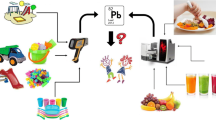Summary
The present study's aim was to compare the levels of lead exposure between 3-year-old children and their mothers in a pottery-producing area, and to assess the levels of lead exposure for 3-year-old children of the parents engaged in pottery-manufacturing work. For these purposes urinary lead, coproporphyrin, and 6-aminolevulinic acid were determined for the children and their mothers, living in a pottery-producing area and in a control area. The mean urinary lead was 9.3 to 10.8 μg/l for the mothers in the pottery-producing area and 10.6 μg/l for the children in the control area. In contrast, among the children in the pottery-producing area, those whose parents had been engaged in the pottery production had a much higher mean urinary lead of 13.6 to 15.8 μg/l. These results suggest that parental work related to lead contributes appreciably to lead exposure for children.
Similar content being viewed by others
References
Alexander FW (1974) The uptake of lead by children in differing environments. Environ Health Perspect 7:155–159
Baker EL Jr, Folland DS, Taylor TA, Frank M, Peterson W, Lovejoy G, Cox D, Housworth J, Landrigan PJ (1977) Lead poisoning in children of lead workers. N Engl J Med 296:260–261
Center for Disease Control (1975) Increased lead absorption and lead poisoning in young children. A statement by the Center for Disease Control. J Pediatr 87:824–830
Dolcourt JL, Hamrick HK, O'Tuama LA, Wooten J, Baker EL Jr (1978) Increased lead burden in children of battery workers: asymptomatic exposure resulting from contaminated work clothing. Pediatrics 62:563–566
Kawai M, Toriumi H, Katagiri Y, Maruyama Y (1983) Home lead-work as a potential source of lead exposure for children. Int Arch Occup Environ Health (Submitted)
King BG (1971) Maximum daily intake of lead without excessive body-burden in children. Am J Dis Child 122:337–340
Kubasik NP, Volsin MT (1973) A simplified determination of urinary cadmium, lead, and thallium, with use of carbon rod atomization and atomic absorption spectrophotometry. Clin Chem 19:954–958
Morton DE, Saah AJ, Silberg SL, Owens WL, Roberts MA, Saah MD (1982) Lead absorption in children of employees in a lead-related industry. Am J Epidemiol 115:549–555
Rabinowitz MB, Wetherill GW, Kopple JD (1973) Lead metabolism in the normal human: stable isotope studies. Science 182:725–727
Ratcliffe JM (1981) Lead in man and the environment. Ellis Horwood, West Sussex
Rice C, Lillis R, Fishbein A, Selikoff IJ (1977) Unsuspected sources of lead poisoning. N Engl J Med 296:1416
Roels HA, Buchet JP, Lauwcrys R (1978) Lead and cadmium absorption among children near a nonferrous metal plant. Environ Res 15:290–308
The Working Group on Lead Contamination (1965) Survey of lead in the atmosphere of three urban communities. US Department of Health, Education and Welfare, Cincinnati
Tomokuni K, Ogata M (1972) Simple method for determination of urinary δ-aminolevulinic acid as an index of lead exposure. Clin Chem 18:1534–1536
Watson WN, Witherell LE, Giguere GC (1978) Increased lead absorption in children of workers in a lead storage battery plant. J Occup Med 20:759–761
Yankel AJ, von Lindern IH, Walter SD (1977) The Silver Valley lead study: the relationship between childhood blood lead levels and environmental exposure. J Air Pollut Control Ass 27:763–767
Ziegler EE, Edwards BB, Jensen RL, Mahaffey KR, Fomon SJ (1978) Absorption and retention of lead by infants. Pediatr Res 12:29–34
Zielhuis RL, del Castilho P, Herber RFM, Wibowo AAE, Sallé HJA (1979) Concentrations of lead and other metals in blood of two and three year-old children living near a secondary smelter. Int Arch Occup Environ Health 42:231–239
Author information
Authors and Affiliations
Rights and permissions
About this article
Cite this article
Katagiri, Y., Toriumi, H. & Kawai, M. Lead exposure among 3-year-old children and their mothers living in a pottery-producing area. Int. Arch Occup Environ Heath 52, 223–229 (1983). https://doi.org/10.1007/BF00526521
Received:
Accepted:
Issue Date:
DOI: https://doi.org/10.1007/BF00526521




